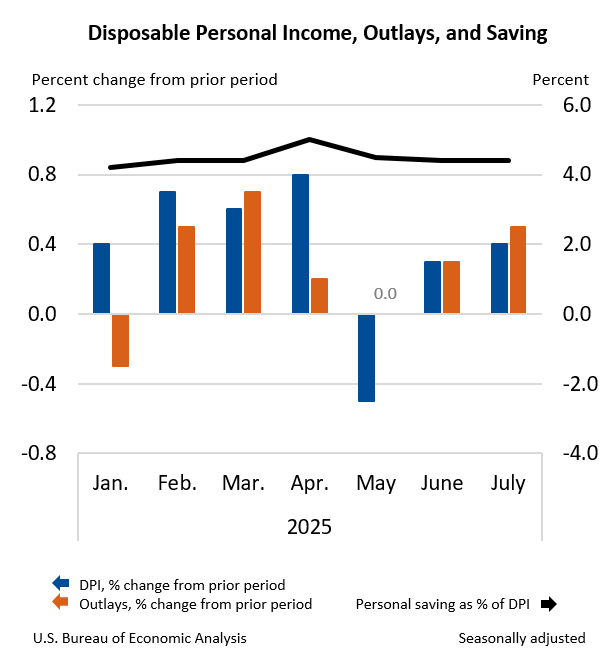Bureau of Economic Analysis
Personal Income and Outlays, July 2025
Personal income increased $112.3 billion (0.4 percent at a monthly rate) in July, according to estimates released today by the U.S. Bureau of Economic Analysis. Disposable personal income (DPI)—personal income less personal current taxes—increased $93.9 billion (0.4 percent) and personal consumption expenditures (PCE) increased $108.9 billion (0.5 percent). Personal outlays—the sum of PCE, personal interest payments, and personal current transfer payments—increased $110.9 billion in July. Personal saving was $985.6 billion in July and the personal saving rate—personal saving as a percentage of disposable personal income—was 4.4 percent.
Principal Federal Economic Indicators
Noteworthy
- 2025 News Release Schedule
- Innovation at BEA
- 2025 Annual Updates
- Distribution of Personal Income Nowcast
- New! Services Trade Data for More Countries
- Data Tool: Trade in Value Added
- Updated: RIMS II Regional Multipliers
- Arts and Culture
- Space Economy
- FDI Now in State BEARFACTS
- Quick Guide: Price Indexes
The Latest
State Quarterly Personal Income, 2nd quarter 2016; State Annual Personal Income, 2015
State personal income growth accelerated to 1.0 percent on average in the second quarter of 2016 from 0.3 percent in the first quarter, according to estimates released today by the U.S. Bureau of Economic Analysis. Personal income grew in every state in the second-quarter with growth rates ranging from 0.4 percent in Alaska to 1.4 percent in Utah (table 1).
U.S. Net International Investment Position Second Quarter 2016
The U.S. net international investment position decreased to −$8,042.8 billion (preliminary) at the end of the second quarter of 2016 from −$7,582.0 billion (revised) at the end of the first quarter.
U.S. International Investment Position, 2nd quarter 2016
The U.S. net international investment position at the end of the second quarter of 2016 was -$8,042.8 billion (preliminary), according to statistics released today by the Bureau of Economic Analysis (BEA). The net investment position at the end of the first quarter was -$7,582.0 billion (revised).
Guam's Economy Grows in 2015
The Bureau of Economic Analysis released estimates of gross domestic product for Guam for 2015, in addition to estimates of GDP by industry and compensation by industry for 2014.
These estimates were developed under the Statistical Improvement Program funded by the Office of Insular Affairs of the U.S. Department of the Interior.
Revised estimates of Guam’s GDP for 2013 and 2014, as well as revised estimates of GDP by industry…
Gross Domestic Product by Metropolitan Area, 2015
Real gross domestic product (GDP) increased in 292 metropolitan areas in 2015, led by growth in professional and business services; wholesale and retail trade; and finance, insurance, real estate, rental and leasing, according to statistics on the geographic breakout of GDP released today by the Bureau of Economic Analysis. Collectively, real GDP for U. S. metropolitan areas increased 2.5 percent in 2015 after increasing 2.3 percent in 2014…
U.S. Current-Account Deficit Decreases in Second Quarter 2016
The U.S. current-account deficit decreased to $119.9 billion (preliminary) in the second quarter of 2016 from $131.8 billion (revised) in the first quarter of 2016. As a percentage of current-dollar U.S. GDP, the deficit decreased to 2.6 percent from 2.9 percent. The previously published current-account deficit for the first quarter was $124.7 billion.
U.S. International Transactions, 2nd quarter 2016
Current Account Balance The U.S. current-account deficit decreased to $119.9 billion (preliminary) in the second quarter of 2016 from $131.8 billion (revised) in the first quarter of 2016, according to statistics released by the Bureau of Economic Analysis (BEA).
Travel and Tourism Spending Accelerated in the Second Quarter
Real Tourism Spending. Real spending on travel and tourism accelerated in the second quarter of 2016, increasing at an annual rate of 4.7 percent after increasing 1.2 percent (revised) in the first quarter, according to new statistics released by the Bureau of Economic Analysis.




